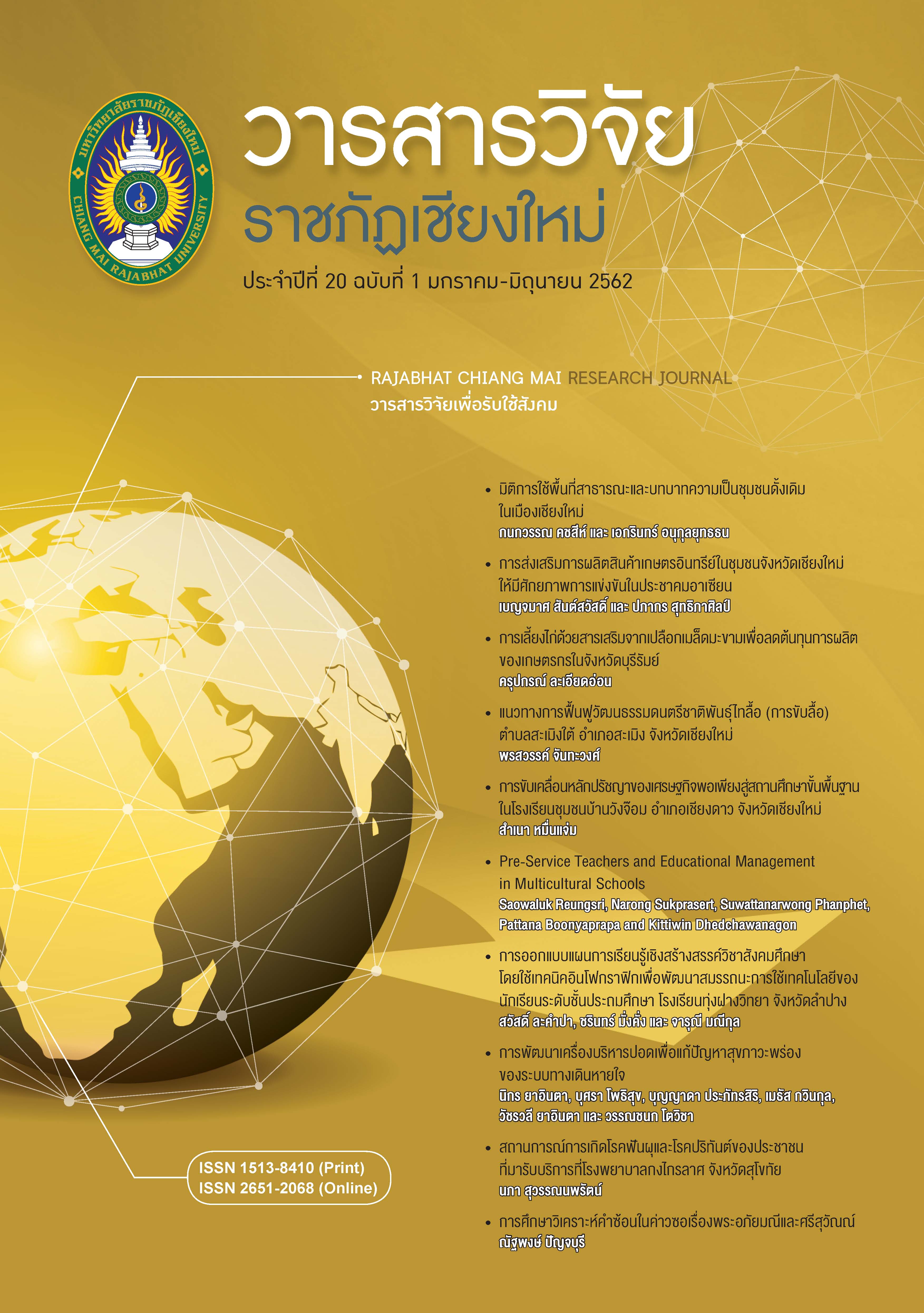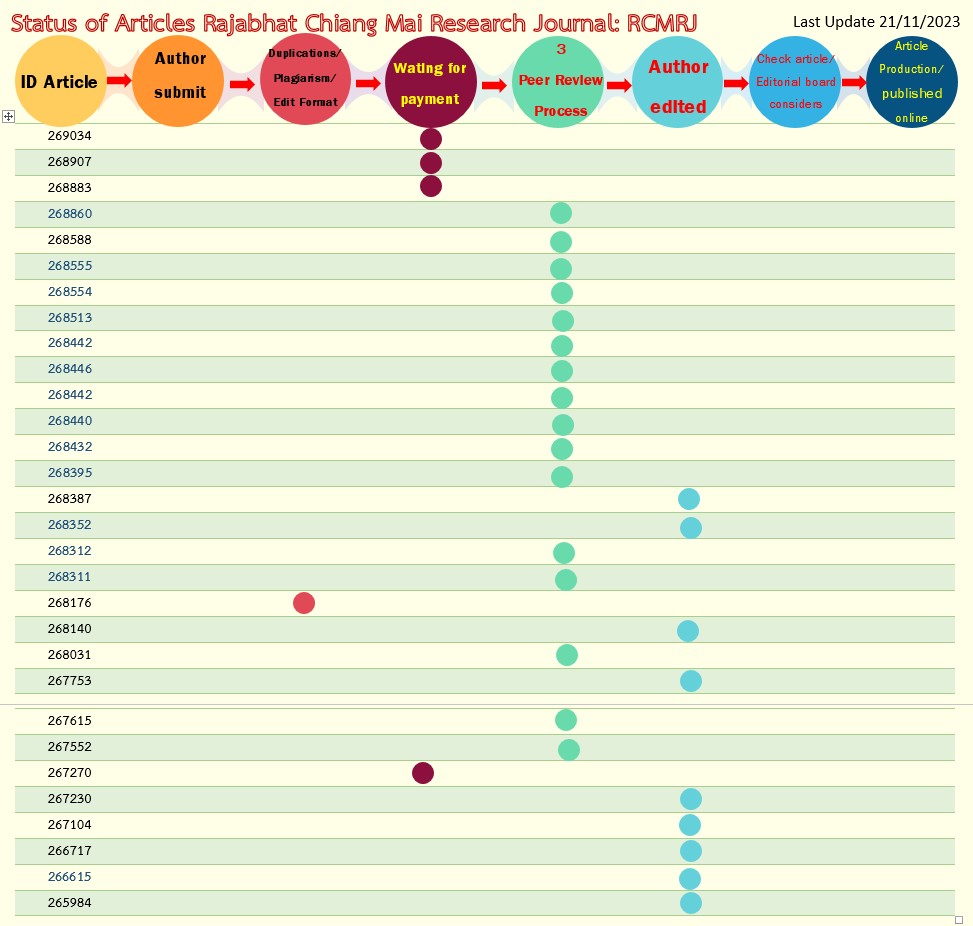Driving the Philosophy of Sufficiency Economy to Basic School in Ban Wangjom Community School Chiang Dao District Chiang Mai Province
DOI:
https://doi.org/10.14456/rcmrj.2019.157243Keywords:
the Philosophy of Sufficiency Economy, Driving, Ban Wangjom communityAbstract
This research aimed to driving the philosophy of sufficiency economy to basic school in Ban Wangjom community school Chiang Dao District Chiang Mai Province. It was an action research with 4 steps which were planning, action, observation, and reflection. The population and the sample group consisted of 447 people which were 1 executive administrator of the school, 14 teachers, 219 students, 204 parents, and 9 representatives from school committee. The research instruments comprised of the analysis form of documents from brainstorming process, observation form, and the evaluation form of the implementing results. The quality of the instruments was determined by Index of Item – Objective Congruence (IOC) from the experts. In addition, the reliability of the evaluation form of the implementing results. was determined by Alpha Coefficient. The analysis of quantitative data composed of percentage, mean, and standard deviation while in the analysis of qualitative data, content analysis was used. The data analysis was presented by descriptive method. The details were as follows:
Driving the philosophy of sufficiency economy to Ban Wangjom community school comprised of 10 activities. 1) The first activity was to analyze document and brainstorm in order to study problems and the current needs to drive the philosophy of sufficiency economy in Ban Wangjom Community School. It was found that in the past two years, teachers were moved to another school and new teachers were enrolled in this school; as a result, the implementation of the first activity was not consistent. The teachers did not have a clear understanding of the learning activities that integrated the Philosophy of Sufficiency Economy. The students tended to be attracted by western values and became more materialistic. They used technology inappropriately. They were dishonest and impatient. They were not economic and willing to learn. The teachers, students, parents, and school committee wanted the students to learn more about the Philosophy of Sufficiency Economy. 2) The second activity was to analyze and brainstorm the plan to implement the Philosophy of Sufficiency Economy by creating a table to implement the Philosophy of Sufficiency Economy in Ban Wangjom community school. 3) The third activity was to conduct a workshop to review annual action plan by implementing 12 projects related to the Philosophy of Sufficiency Economy in Ban Wangjom community school. 4) The forth activity was to conduct a workshop on 6 projects to develop the learners using the Philosophy of Sufficiency Economy. 5) The fifth activity was to design the lesson plans that integrates the Philosophy of Sufficiency Economy in 11 learning units. 6) The sixth activity was to follow the results of the lessons plan. It was found that 9 out of 11 lesson plans were completed with learning activities and pre-test as well as post-test. However, there were structural problems that were created to trigger Philosophy of Sufficiency Economy thinking in the last two learning units. It was found that the teachers had problems in creating learning activities; therefore, the researcher helped to solve the problems and share some knowledge. The problems later were solved. 7) The seventh activity was to identify the quality of the learning units, lesson plans, and learning activities plans by using IOC from 5 experts. According to the content validity, it was found that the language usage was proper and well compatible with the learning issues. 8) The eighth activity was to provide learning activities that integrated the Philosophy of Sufficiency Economy and to conduct pre-test and post-test regarding the Philosophy of Sufficiency Economy. It was found that the students from Grade 1-9 had better understanding of the Philosophy of Sufficiency Economy. The post-test scores were higher than the pre-test scores and it was ranged between 22.11 – 28.38. 9) The ninth activity was to observe and conduct a meeting in order to discuss about the problems that the teachers had during the experiment and to solve the problems. 10) The tenth activity was to reflect the results of the drive of the philosophy of sufficiency economy in Ban Wangjom community school.
The results showed that in general the quality of the implementation was in high level in every aspect. The highest score was in the school management aspect. The subordinate one was successful results aspect and the curriculum and learning activity aspect respectively. The lowest score was in activities to develop the students.
According to the results, it was discovered that the general implementation was in high level. Every element was also in high level. The highest score was in the element of school executive administrator and the subordinate one was the teacher element and student element respectively. The lowest one was educational institution element.
References
จันทร์จิรา บุญมี. (2557). แนวทางการดำเนินงานตามหลักปรัชญาของเศรษฐกิจพอเพียงโรงเรียนมัธยมศึกษา จังหวัดอุทัยธานี สังกัดสำนักงานเขตพื้นที่การศึกษามัธยมศึกษา เขต 42. วิทยานิพนธ์ครุศาสตรมหาบัณฑิต มหาวิทยาลัยราชภัฎนครสวรรค์.
จุฑามาส พัฒนศิริ. (2560). แนวทางการบริหารสถานศึกษาตามหลักปรัชญาของเศรษฐกิจพอเพียงของโรงเรียนในจังหวัดนครสวรรค์ สังกัดสำนักงานเขตพื้นที่การศึกษามัธยมศึกษา เขต 42. วิทยานิพนธ์ครุศาสตรมหาบัณฑิต มหาวิทยาลัยราชภัฏนครสวรรค์.
เฉลิมชัย ตาระกา. (2558). การขับเคลื่อนปรัชญาของเศรษฐกิจพอเพียงตามทัศนะของผู้บริหารสถานศึกษาและครูในโรงเรียน สังกัดสำนักงานเขตพื้นที่การศึกษามัธยมศึกษา เขต 3. วิทยานิพนธ์ครุศาสตรมหาบัณฑิต มหาวิทยาลัยราชภัฏเทพสตรี.
ชนากานต์ กาหลง. (2560). สภาพและแนวทางการพัฒนาการบริหารสถานศึกษาตามหลักปรัชญาของเศรษฐกิจพอเพียง สังกัดสำนักงานเขตพื้นที่การศึกษาประถมศึกษามหาสารคามเขต 2. วิทยานิพนธ์ครุศาสตรมหาบัณฑิต มหาวิทยาลัยราชภัฏมหาสารคาม.
พงศธร โพธิแก้ว. (2560). ลักษณะผู้บริหารมืออาชีพตามทัศนะของผู้บริหารและครูในโรงเรียนอำเภอเมือง จังหวัดพะเยา สำนักงานเขตพื้นที่การศึกษามัธยมศึกษาเขต 36 .วารสารวิจัยราชภัฏเชียงใหม่, 18(2), 109-120.
รัชนีกร วงศ์จิราษฎร์. (2559). บทบาทของผู้บริหารสถานศึกษาในการส่งเสริมการจัดการศึกษาตามแนวปรัชญาเศรษฐกิจพอเพียง ในกลุ่มโรงเรียนค่ายพระเจ้าตาก สังกัดสำนักงานเขตพื้นที่การศึกษาประถมศึกษาระยอง เขต 1. วิทยานิพนธ์การศึกษามหาบัณฑิต มหาวิทยาลัยบูรพา.
สำนักงานคณะกรรมการพัฒนาเศรษฐกิจและสังคมแห่งชาติ. (2554). แผนพัฒนาเศรษฐกิจและสังคมแห่งชาติ ฉบับที่ 11. กรุงเทพฯ: สํานักนายกรัฐมนตรี.
สำนักงานคณะกรรมการพัฒนาเศรษฐกิจและสังคมแห่งชาติ. (2559). แผนพัฒนาเศรษฐกิจและสังคมแห่งชาติ ฉบับที่ 12. กรุงเทพฯ: สํานักนายกรัฐมนตรี.
สุดารัตน์ กุมขุนทด. (2559). แนวทางการบริหารสถานศึกษาตามหลักปรัชญาของเศรษฐกิจพอเพียงในโรงเรียนขนาดเล็ก สังกัดสำนักงานเขตพื้นที่การศึกษาประถมศึกษานครสวรรค์ เขต 3. วิทยานิพนธ์ครุศาสตรมหาบัณฑิต มหาวิทยาลัยราชภัฏนครสวรรค์.
สุธรรม ธรรมทัศนานนท์. (2560). การพัฒนารูปแบบการบริหารจัดการตามหลักปรัชญาของเศรษฐกิจพอเพียง สำหรับสถานศึกษาสังกัดสำนักงานเขตพื้นที่การศึกษามัธยมศึกษา เขต 27. วารสารศึกษาศาสตร์, 28(1), 140-153.
อัจฉราพร ภักดีสมัย. (2555). การพัฒนาบุคลากรด้านการจัดกิจกรรมการเรียนรู้โดยใช้หลักปรัชญาของเศรษฐกิจพอเพียง โรงเรียนบ้านบกห้วยโนน อำเภอศรีรัตนะ จังหวัดศรีสะเกษ. วิทยานิพนธ์การศึกษามหาบัณฑิต มหาวิทยาลัยมหาสารคาม.
Downloads
Published
How to Cite
Issue
Section
License
1. Articles, information, content, images, etc. that are published in "Chiang Mai Rajabhat Research Journal" is the copyright of Chiang Mai Rajabhat Research Journal. Chiang Mai Rajabhat University. If any person or organization wants to distribute all or any part of it or do any action Must have written permission from the Chiang Mai Rajabhat Research Journal, Chiang Mai Rajabhat University.
2. Content of articles appearing in the journal is the responsibility of the author of the article. The journal editor is not required to agree or take any responsibility.














